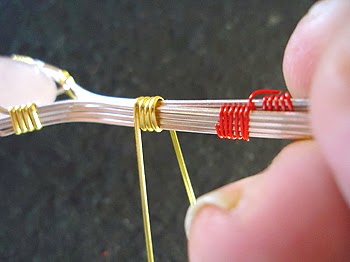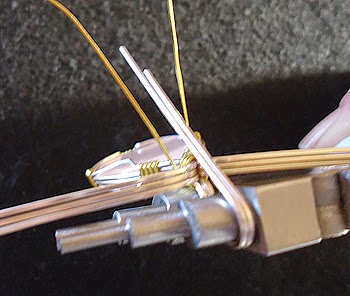Making Wire Wrapped Bails

Following on from my previous post where I showed you how to create the setting for the stone I will now outline a very simple way to make a bail.
Cut around 12" of half round wire. I find that wrapping the wire around my flat nose pliers makes a perfect fit to start wrapping for the bail. Holding the flat side down leave around 2" of wire sticking out to the left.
Using my thumb I will push the wire down and my finger to bend it around.
This can then be hung on the square wires above the setting.
It can now be wrapped around 4 times just like when we did the wraps for the setting. I am leaving my red guide wires on for now as they stop the square wires splaying out and bending before I want them to.
Taking my flat nose pliers I give the wrap a squeeze to tighten and smarten them up. I still want them to be able to move.
I now want to fix the setting in place and put it under tension to give it strength. A little above the top of the stone I will squeeze the wires together with flat nose pliers.
This will allow me to move the wrap I just did down as far as possible to lock everything together.
Having moved the wrap down I can remove the last of the red guide wires. Separate the front 2 wires and bend them forward a little.
Placing my thumb beneath them I bend them down tight on the wrap until they are sticking out in front. This locks the wrap in place stopping it moving back up.
There will now be 3 wires on each side that must be bent down. On the left side I place my thumb against the wrap again and bend the wires down until they are straight out. Repeat for the right side.
This is how it should look with all the wires bent down.
I like to use my bail making pliers to form the bail as it makes the job simple and uniform each time but any object can be used. Before I invested in bail making pliers I used a pen to create my bails.
Gripping the front 2 wires close to the 2 side wires I use my thumb to bend the wires up and back a little. I find this works much better than trying to use the pliers to make the bend.
Removing my pliers you can see that I have formed a shepherds hook.
Putting my pliers back in I can continue the bend until it is flat against the back of the stone and I can hold it tight with my thumb.
Using the longer of the 2 half round wires I want to wrap it completely around the bail covering the original 4 wires and leaving both wires sticking out at the back.
This is how it looks once I have wrapped it.
Taking my flat nose pliers I will give the wrap a squeeze just to tighten and straighten it.
Crossing over the two half round wires I twist them together for about 10mm.
I can cut off the excess leaving just under 10mm.
Gripping the little 'tail' that I left with my flat nose pliers I twist and straighten them. You have to be a little careful not to over tighten them or they will break off.
Making sure that they are equal, I part the 2 bail wires to give them greater visual interest as well as keeping them in place. If you find one is a little bigger than the other they can be aligned with a gentle tweak of your round nose pliers.
I'm going to tuck away the little 'tail' but before I can do that I need to part the 2 wires that are hanging down the back of the stone.
To tuck away the tail I take my round nose pliers and grip the end of the tail bending down and inwards.
Once I have made the tail into a hook I can easily push down on it which should place it neatly between the legs and up into the bail. It will hardly show from the front and it is a neat way of finishing it off.
I may need to apply a little pressure to the hook with the back of mu pliers to get it to go in far enough out of the way.
The same is true if it feels a little rough. Some gentle pressure with the back of the pliers will flatten it out and make it smooth.
If you are at all worried about it you can apply a small amount of glue once the legs have been pushed back in.
I use my flat nose pliers to bend the two wires in just below the tail to keep it in place.
I know that many jewellery makers give little thought to the back of the stone but I like to pretty it up a bit anyway. Cutting the legs to the size I want I can use my round nose pliers to give them a curl. This not only makes them more attractive but hides any rough edges from the cut. If you are not curling the wires back you may need to use a file or a cup burr to remove any sharp edges.
I will normally press the legs into the back of the stone so that they lie against it well and not stick out.
This is the stage I will do my initial polishing of the wires and stone with my silver cloth. Once I start bending the spare wires down it will be harder to get into all the little spaces with my polishing cloths or my dremel with a polishing wheel.
I will give it a full polishing once it is completed to make sure I remove any fingerprints etc.
That's the end of making the bail. In the next post I will begin bending down the wires into interesting shapes. This is the most fun part for me as I never know what I am going to do until I do it. This keeps my creations unique and different each time.























































